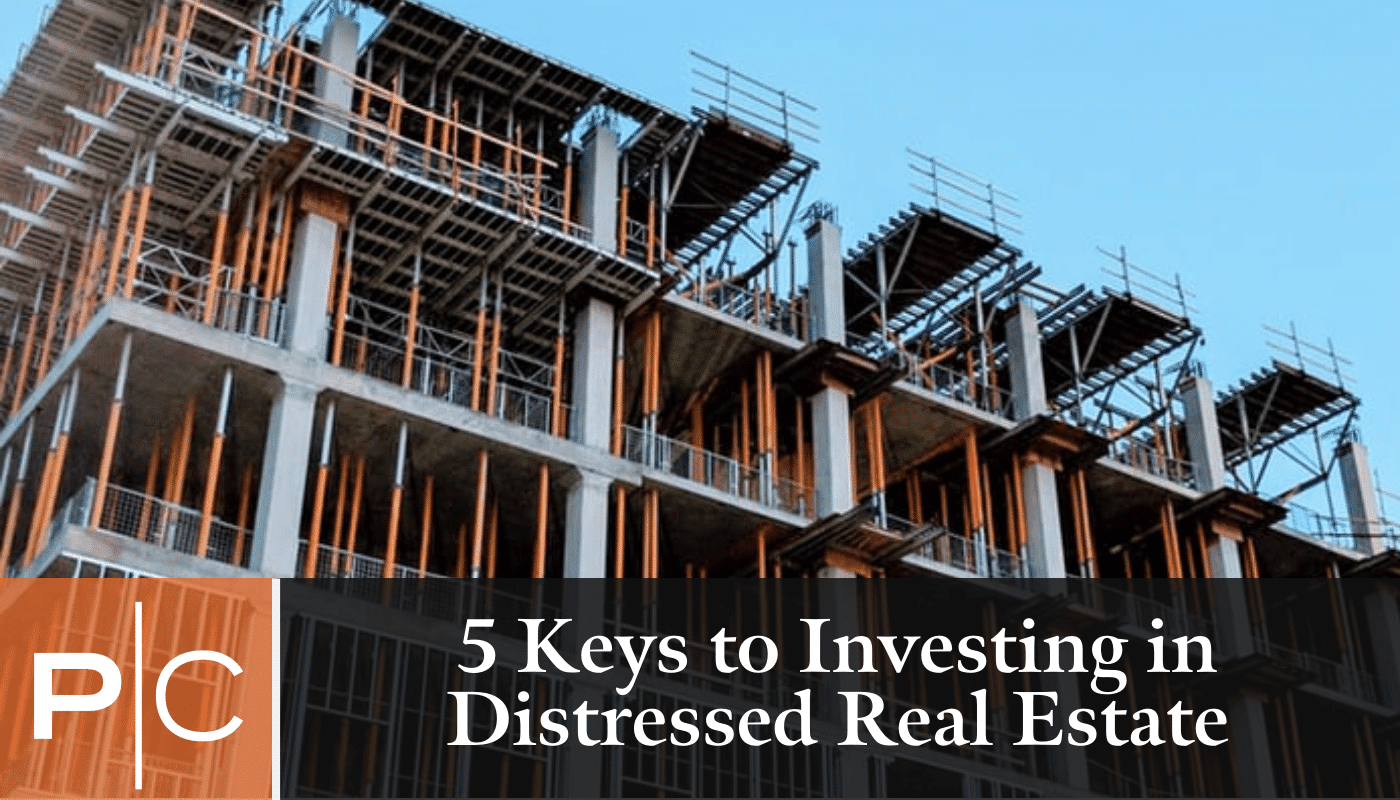5 Keys to Investing in Distressed Real Estate
By Ed Rogan, Owner, Co-Founder

Buying distressed real estate certainly isn’t for the faint of heart. An inexperienced investor can easily be swayed by the promise of a project sponsor who doesn’t actually have a plan for turning the property around. But that doesn’t mean you shouldn’t invest in distressed real estate. It just means you should tread lightly before doing so. Be sure you really understand the nuances of a deal before committing your hard-earned capital.
The Promise of Distressed Real Estate
There are any number of reasons why a property might be considered “distressed.” An owner may be too highly levered, for example, and is now underwater on their mortgage. Unable to afford the improvements needed to increase rents and/or occupancy, the property is now at risk of foreclosure.
Another example we often see is when an inexperienced owner overpays for a property and then tries to manage it passively. Commercial real estate is a great way to earn passive income, but that doesn’t mean it can survive without strong management. Someone, even if not the owner, must keep a close eye on day-to-day operations of the property. In situations like these, the property often suffers from delayed repairs and maintenance, which turn into bigger problems down the road.
Consider the case of a small roof leak that gets ignored. Well, as it turns out, what seemed like a small leak was actually a sign of a rotting roof deck and sheathing. All it would take is a strong rainstorm to roll through in order for the roof to collapse. The absentee owner quickly learns that it’s difficult to rent out a property with a collapsed roof, and now must endure high vacancy while the repairs are made, putting the property into further distress.
Believe it or not, situations like these are not uncommon at all. People often get excited about investing in commercial real estate, but unfortunately, lack the knowledge or skills to maintain and operate it effectively. It’s often the case that distressed real estate is a fantastic buy, despite the condition of the property. Here are five keys to investing in distressed real estate.
Sign up to receive our educational newsletter and to gain exclusive access to our next investment opportunity.
1. Understand the property history.
Start by understanding why this property is distressed to begin with. Specifically, you’ll want to know whether it had something to do with poor management, actual property deficiencies, or whether it had something to do with the economics of the deal. For example, does the owner need to achieve $1500/month in rent per unit in order for this project to be viable, yet market rents only support $1200/month? Does the property need $2 million in improvements in order to bring it in line with market conditions—and if so, is that something the project can bear? Before investing in distressed real estate, be sure you understand how the property wound up in this situation so you can avoid ending up in the same place down the road.
2. Learn about the underlying market drivers.
Let’s say a property is in foreclosure and being sold for pennies on the dollar. It is tempting to buy distressed real estate when you think you’re getting a “steal” compared to what it’s sold for previously. This shouldn’t be the basis for your investment. Instead, look at the underlying market drivers. Is the property located in a good area? Is there a strong local economy? Is the population growing? What would bring people here? Why would someone want to rent from you, and how much would they be willing to pay for rent?
Now, if you’re buying a property in a prime location and buying the structure for the price of the raw land, you can’t lose. It’s only upside from there. With a few cosmetic improvements, you can go in and lease the place up – even for 50% below market – and still make your money back. When the underlying market drivers are strong, distressed real estate can have exponential upside.
3. Get to know the project sponsor.
Before investing in distressed real estate, get to know the team that’ll be in charge of turning the property around. Have they done this before? What is their experience? How familiar are they with this asset class? For example, you wouldn’t necessarily want to partner on a multifamily value-add deal if the sponsor has only flipped retail centers. These are two totally different product types. You want to be sure the sponsor has adequate experience in the product type you’re looking to invest in—ideally, in the same market where this deal is located. Commercial real estate is hyper-local, so having local expertise (including having local market knowledge, relationships with local lenders and contractors, etc.) can greatly influence the success of a deal.
4. Evaluate the exit strategy.
Someone has approached you to invest in distressed real estate, and based on what they’ve told you, it seems too good to be true. Is it? Evaluate the sponsor’s business plan, paying close attention to their exit strategy. What is the strategy for renovating, leasing, and stabilizing the property? Does the syndicate plan to buy and hold the asset, refinance, or flip and sell? Investing in distressed real estate can be highly lucrative, as long as you understand the exit strategy and how and when you’ll be paid back (with profits).
5. Weigh potential risks and returns.
As with any investment opportunity, you should evaluate the potential risks and returns associated with distressed real estate. Every investor has their own risk tolerance. Generally, those with a higher risk tolerance will be more amenable to investing in distressed real estate given the potentially higher risks associated with these projects. Naturally, a strong project sponsor will be able to mitigate those risks, but the risks remain.
The risks must then be weighed in relation to potential returns. Let’s say you can earn a 12% cash-on-cash return by investing in a particular distressed asset. Could you achieve that same rate of return elsewhere? Over what time horizon? Of course, any investment should be made in the context of your broader investment portfolio.
Conclusion
Commercial real estate can become distressed for several reasons, some of which are harder to overcome than others. With strong project management and oversight, an adept sponsor will find creative ways for turning these properties around. Yet that process can take time and is usually far from a slam dunk. Anyone contemplating investing in distressed real estate should be sure to go in eyes wide open. The five considerations outlined above will help you do just that.
RELATED ARTICLES
Gaining an Edge through Cold Calling
Gaining an Edge through Cold Calling By Ed Rogan, Owner, Co-Founder In many ways, commercial real estate is an “eat what you can kill” industry. The most successful investors, developers, brokers and other CRE professionals earn their living by scouring the market to uncover the next big deal. Ask the industry’s best and they’ll often…
READ MORE >Trial by Fire: How We Got Started
Trial by Fire: How We Got Started By Ed Rogan, Owner, Co-Founder People often use the term “trial by fire” to explain how they learned something. In our case, the term is all too appropriate. Looking back on it, the story of how Percy and I got started almost seems unbelievable. We were just…
READ MORE >For the Love of Apartment Investing
For the Love of Apartment Investing By Ed Rogan, Owner, Co-Founder So you’ve decided to take the leap and invest in commercial real estate – congrats! Now, where to get started? There are so many options to choose from! Commercial real estate is a catch-all term for describing many different types of income-generating property.…
READ MORE >


